By Justin Brackenrich
Brood Cows
Many livestock owners graze mature cows or cows with calves. Using crop fields to graze corn stalks after grain harvest is a popular management practice in many places around the country. For many farms and ranches this coincides with the middle third of gestation, when the cow has the lowest nutritional demand. At this stage of production, she is not lactating and can be maintained on minimal quality forage.
Cows can also be used to graze live cover crop forages during the growing season. Forages grazed at the proper stage of maturity will provide adequate nutrition for the cow, which will likely be nursing a calf at the same time and will be in a stage of high nutritional demand.
For fencing decisions, the livestock owner should know their cattle and understand their general level of docility (i.e., how flighty they are). This needs to be considered objectively as cows with greater flight risk have greater fencing needs. Other considerations include the proximity to roads and neighboring homes, forage availability, etc. Inadequate fencing creates a liability risk for the livestock owner.
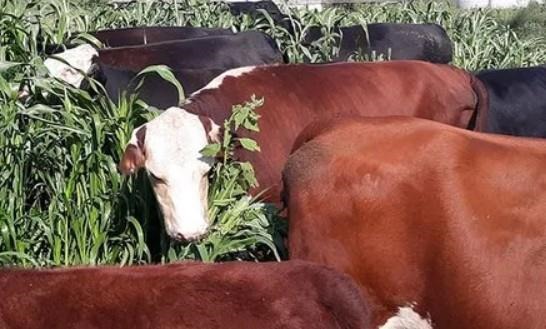
There are several ways that beef cow owners can integrate cow grazing into cropping systems. These cows are grazing pearl millet, a warm-season annual forage grass. Photo courtesy of Timothy Heyler, Lycoming County Conservation District.
Soils are an important consideration with grazing mature cows. Become familiar with the soil types of the cropland being considered and pay special attention to drainage characteristics. Soil types for any land can be found at the USDA web soil survey. The mature cow is our heaviest option for cropland grazing and can create severe damage on poorly drained soils during unusually wet weather periods. Research on compaction caused by animal grazing in cropping systems generally looks favorable for grazing, but if the soil type is inherently poorly drained, this can become a problem.
The mature cow and calf have sizable water demands (see Table 1). The owner needs to thoroughly evaluate the water supply's production and quality to ensure their demands can be met. Water distribution system and supply tubs must have enough capacity for livestock needs.
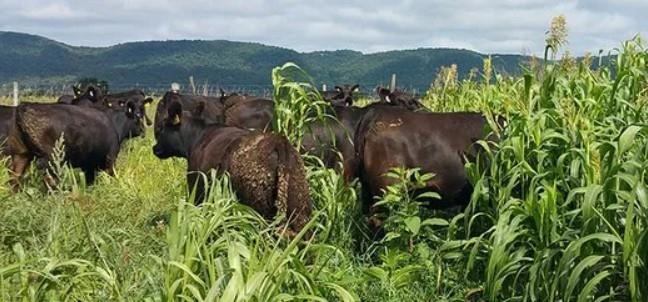
Stocker and grass-finishing cattle programs can integrate with cropping systems to utilize high quality cool- and warm-season annual cover crop forages. These cattle are grazing a mixture of warm season annual cover crop species. Photo courtesy of Dr. Jessica Williamson.
Stocker and Grass-finishing Cattle
The main goal of grazing stocker or grass-finishing cattle is to promote profitable weight gain. Stocker and grass-finishing cattle can integrate very well with cropping systems. Using stocker cattle to graze wheat fields in the southwestern United States is very common. High-quality annual forages grazed at the correct stage can promote high rates of weight gain and can be used to finish cattle. Much of the future growth in demand for grass-finished cattle will likely be supplied by cattle finished in grazing programs integrated into cropping systems.
Fencing is an extremely important consideration with stocker cattle. Younger cattle can be easily frightened and could be flighty, depending on their background, exposure to people, stress levels, etc., especially if they have not been raised on the farm. Inadequate fencing could easily be breached by agitated cattle and result in liability issues and lost cattle. Recently purchased stocker cattle that breach the fence may not know where "home" is and roam far from the farm.
When managing cattle for weight gain, strict attention needs to be given to stages of maturity in the forage plants and resulting nutrition. Forage mixtures that are allowed to become overly mature will lose energy and protein as they become more fibrous. Producing forages with high energy levels is the goal to drive weight gains.
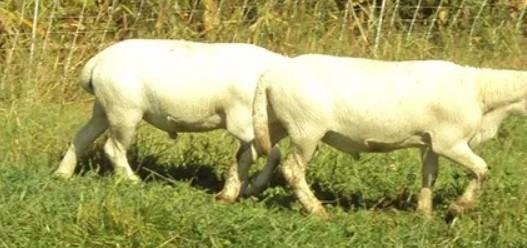
Modern fencing materials, low water usage, and ease of transportation give sheep and goats significant potential to integrate into a cropping system. Photo courtesy of David W. Hartman
Sheep and Goats
Sheep and goats (small ruminants) have significant potential to integrate into an existing cropping system. Small ruminants have the advantage of being easily transported to new sites. Furthermore, they can readily be finished to market weight on only forages.
A major advantage for grazing small ruminants within cropping systems, compared to cattle, is the option to use electric netting fence to manage the grazing and serve as an exterior fence. This significantly reduces fencing expenses compared to building an exterior fence as a physical barrier. Electric netting is easily moved within fields, among fields, and to other farms. The fence can be charged via a solar charger. Sheep and goats very rarely challenge an electric netting fence if sufficient voltage is in the fence and forage availability is adequate inside the fence boundaries.
Small ruminants are efficient water users, and at various times during the grazing season the moisture content within the forage will supply their needs. Therefore, water supply and distribution may be less of a challenge than with cattle. Water still needs to be available at all times, but small ruminant owners may find that their animals use little to no water during the cooler parts of the grazing season. Refer to Table 1 at the end of the article for water volume requirements.
Small ruminants are plagued by the dual threat of predators and parasites. Electric netting has proven to be an effective barrier against terrestrial predators such as coyotes, but it is not foolproof. Stray or neighborhood dogs can be another significant predator of small ruminants. Producers grazing in areas with high predator populations may still want to consider guard animals as insurance against predators.
Internal parasites are a constant threat to small ruminants and require management to minimize their populations and herd/flock exposure. Grazing within a cropping system may be an advantage in the battle against parasites since the fields may see minimal grazing pressure during a season and therefore fewer parasite eggs being deposited on the field. Allowing the animals to graze taller forage stands will also reduce their exposure to parasite larvae, which typically only inhabit the first few inches of a plant above the soil surface.
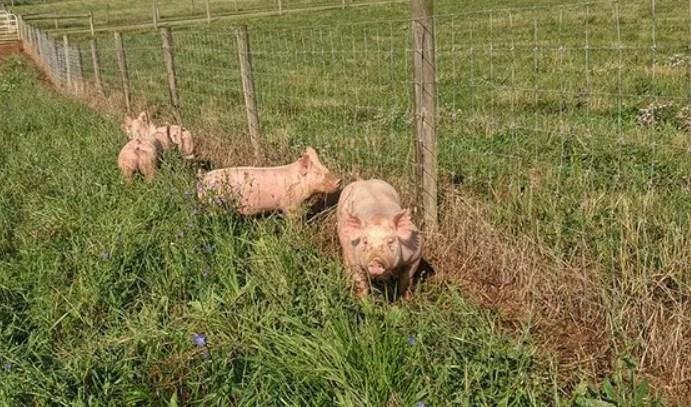
Hogs can be integrated into a cropping system to utilize cover crops but need to be managed to avoid soil damage. Photo courtesy of Dr. Elizabeth Hines
Swine
Interest in raising hogs in outdoor systems continues to grow. Although hogs cannot utilize forage as efficiently as ruminants, forages can be an integral part of their diet as long as supplemental feed grains are available. The need for supplemental feeding can complicate the decision to integrate swine grazing into a cropping system.
Hogs can be grazed on hay crops grown within cropping rotations. Examples would be red clover, alfalfa, and orchardgrass. They can also graze temporary or annual crops such as oats, peas, summer annual grasses, and winter annual grasses. Swine can also be used to "hog down" mature crops such as field corn. This involves allowing the crop to mature, then using the hogs to harvest the mature corn ears.
Swine owners who want to integrate hog grazing into cropping systems need to be focused on managing the hogs so they do not cause damage to soil by rooting. Maintaining a low stocking rate can help reduce incidence of rooting. High stocking rates tend to be associated with high levels of soil disturbance. The grazing manager needs to be tuned in to managing the grazing and knowing when to rotate the hogs to the next paddock before they begin to cause soil damage. Hogs also have a tendency to create wallows near water sources or water pipe leaks, or in undulations in the terrain. Some producers use nose rings to deter the hogs from rooting.
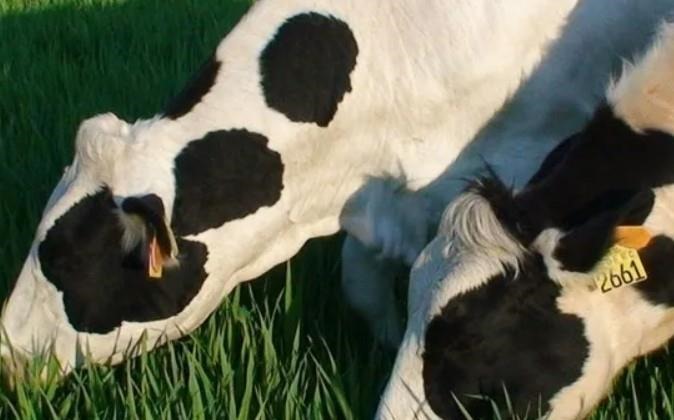
Cover crop grazing can be a low-cost feed source for dairy heifers and dry cows. Photo courtesy of Dr. Kathy Soder, USDA-ARS
Lactating Dairy Cows
In most situations, grazing cropland with lactating dairy cows will not be a viable option. A cover crop with high nutritional quality that is close to the barn may present an opportunity. But in most situations the logistics and time involved in moving lactating cows two times each day to the barn for milking will be prohibitive.
Dry Cows (Dairy)
Cover crop forages can provide a low-cost feed source to early dry cows that are at least four weeks away from calving, as their nutrient requirements are relatively low compared to lactating cows. There can also be numerous benefits to animal health, including improved legs and feet by getting cows off concrete, and increased calving ease due to additional exercise. However, there can also be some drawbacks. Close-up cows (within three weeks of calving) have greater nutrient needs, and pasture alone may not provide sufficient nutrients. Close-up cows will either need supplementation on pasture or they will need to be removed from pasture and placed on a higher plane of nutrition. Grass pastures in the Northeast, particularly those with a long history of manure application, can be very high (often exceeding 3 percent) in potassium, which can predispose cows to metabolic issues such as milk fever if fed during the latter part of pregnancy. The incidence of milk fever varies widely between herds, so decisions must be made on a herd basis. If milk fever is a problem in your herd, it is recommended to remove dry cows from high-potassium pastures (this is where a forage test is a critical management tool) during the last three to four weeks of pregnancy, dilute high-potassium pastures with other low-potassium forages, or establish low-potassium pastures (through strategic fertilization) specifically for use by dry cows.
While dry cows have lower nutrient requirements than lactating cows, they still need the quality and quantity of pasture to meet their nutrient needs. They cannot just be "turned out on the back forty and forgotten" until calving time arrives. Rotational grazing is still recommended but can be at a lower rotation rate (every one to three days rather than twice a day as with lactating cows).
All grazing animals should have access to shade (or kept in the barn) during extremely hot periods. They also need a good source of clean water. While some ponds and springs look good in the spring, they may become stagnant or dry up during summer. They should also be provided with a mineral source appropriate for their stage of production if the mineral is not being provided in a supplement.
Dairy Heifers
Dairy heifers six months of age or older can be maintained on quality cover crop pasture. Animals younger than this do not have sufficient rumen development to fully utilize high-forage diets and should remain on diets with greater digestibility or provided with supplements while on pasture. Heifers six to twelve months of age should be provided some high-energy grain to meet the nutrient demands of these growing animals. Heifers greater than twelve months of age can be raised on good-quality pasture during spring and early summer. However, when pasture quality declines in mid-summer due to increased temperatures and decreased precipitation, supplementation may be necessary
Heifers should be treated regularly for control of internal parasites. These young animals have immature immune systems and have not yet been exposed to parasites to develop any resistance, so they are more susceptible to internal parasites than mature animals are. Flies must also be controlled to help reduce incidence of pinkeye and improve animal welfare and growth.
Heifers can be used in a leader-follower system where mature cows graze first, followed by the heifers. It is important to decrease the grazing time of the mature cows in each paddock so that sufficient forage of adequate quality remains for the heifers. However, this system is not recommended for herds that are on a Johne's disease eradication program as the manure from the mature cows can infect the younger animals. In this case, separate pastures must be used for heifers, and manure from mature cows should not be spread on heifer pastures, as the organism that causes Johne's can live for a long time on a pasture.
Water Consumption
Supplying the necessary quantity and quality of water is critical for maintaining healthy livestock. Before beginning to graze livestock or dairy cattle in conjunction with a cropping system, make sure that your water supply and distribution system can deliver enough water to the animals each day. This includes during the heat of summer when water quantity needs are at their highest. Table 1 below provides guidelines on how much water will be needed.
Table 1
| Livestock Species | Water Needed per Animal
50-Degree Day | Water Needed per Animal
90-Degree Day |
|---|
| Dry Beef Cows | 8–12 Gallons | 20–30 Gallons |
| Lactating Beef Cows | 12–20 Gallons | 25–35 Gallons |
| Lactating Dairy Cows | 20–30 Gallons | 30–40 Gallons |
| 600-Pound Weaned Calves | 6–9 Gallons | 10–15 Gallons |
| Sheep and Goats | 2–3 Gallons | 3–4 Gallons |
Table taken from Watering Systems for Serious Graziers, produced by Natural Resources Conservation Service
Conclusion
Cover crops within crop rotations can provide low-cost forage for grazing. It is important for the livestock owner to understand nutritional, infrastructure, and other needs of their class of livestock.
David W. Hartman, Penn State Extension; Dr. Kathy J. Soder, Research Animal Scientist, USDA-ARS at University Park, PA; Dr. Sjoerd W. Duiker, Soil Management Specialist, Department of Plant Science, The Pennsylvania State University; Justin L. Brackenrich, Penn State Extension; Divya Pant, graduate student, Department of Plant Science, The Pennsylvania State University
Source : psu.edu